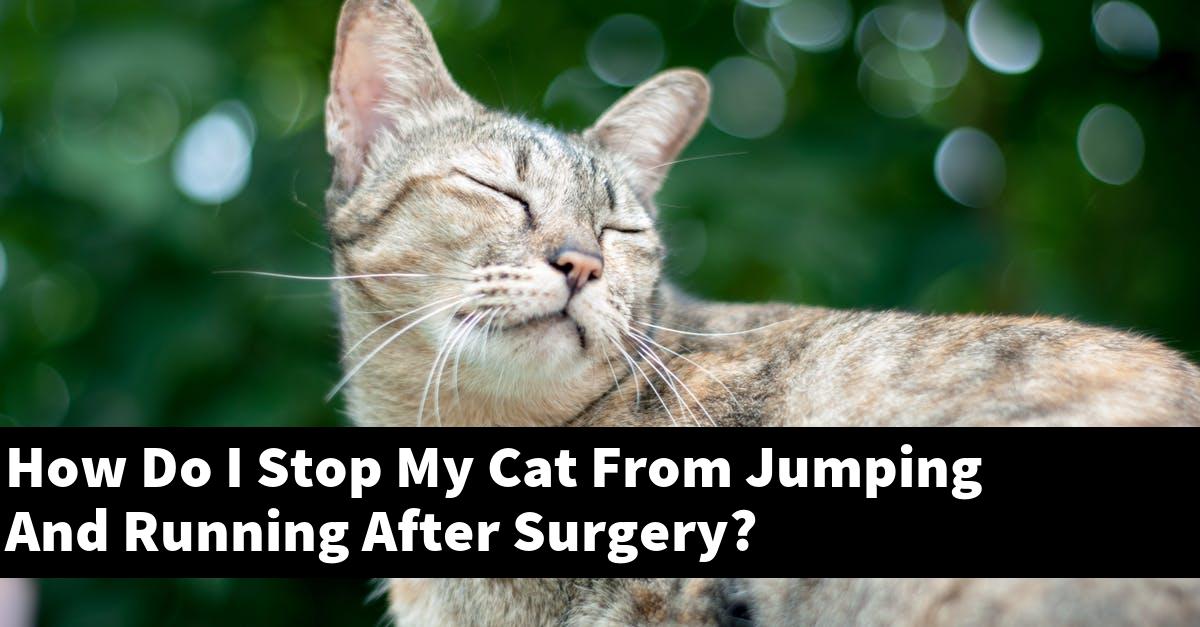After a cat undergoes surgery, it is important to keep them calm and prevent them from jumping and running around too much. This can be done by confining them to a small space, such as a bathroom, and providing them with a soft bed and plenty of toys to keep them occupied.
It is also important to keep them away from other pets and children, as they may accidentally hurt themselves.
Why is my cat so active after surgery?
There can be many reasons why a cat may become more active after surgery. Veterinarians typically prescribe pain medication to help the cat relax and avoid discomfort.
Some cats may also be more active to compensate for the loss of their ability to move around. In some cases, the surgery itself may cause the cat to become more active.
For example, if a cat had to have a tumor removed, they may be more active to help move the surgery site and avoid being still.
How long should I keep my cat from jumping after surgery?
There is no specific answer, as each individual case will be different. However, generally it is recommended to keep cats from jumping for at least one week after surgery.
This is to ensure that the cat has fully recovered and there are no complications.
How can I calm my cat down after surgery?
There are many things that you can do to calm your cat down after surgery. Some common things include providing them with a warm, comfortable place to rest, giving them water or food, and playing with them.
You can also try to calm them by speaking to them in a calm, gentle voice, and patting them on the back.
How do I keep my cat calm after being spayed?
If your cat has been spayed, there is a very small chance that she will be pregnant again. If your cat becomes excessively anxious, vocal, or aggressive after her surgery, it is possible that she is pregnant and is having an early miscarriage.
One way to help your cat cope with the surgery and any potential pregnancy is to provide plenty of soothing and calming activities. Some ideas include playing with your cat, providing a quiet place for her to rest, and providing her with favorite treats and toys.
Can cats be hyperactive after anesthesia?
It is largely dependent on the individual cat’s personality and how they are normally behaved. Some cats may be more active and vocal after anesthesia than others, but there is no guarantee that all cats will be hyperactive.
It is generally recommended that cats remain calm and inactive during their anesthetic procedures to avoid any potential complications.
Is it okay for my cat to play after being neutered?
It depends on the individual cat and their particular personality. Some cats may enjoy playing with their toys after being neutered, while others may simply enjoy being active and exploring their new surroundings.
If your cat seems to be enjoying themselves and is behaving in a healthy and normal manner, there is no reason why they cannot play after being neutered.
What happens if a cat jumps after surgery?
There are a few potential complications that could arise from a cat jumping after surgery. The most common is a fractured neck, which can occur when the cat rebounds off the ground and hits their head on the floor.
Another potential complication is a ruptured aneurysm, which is an abnormality on the surface of an artery that can cause sudden death if not treated.
How do I stop my cat from messing with stitches?
There are a few things you can do to try and stop your cat from messing with stitches. One thing you can try is to keep the area where the stitches are located clean and dry.
This will help to keep the area from becoming infected. You can also try to keep your cat away from the area.
If this is not possible, you can try to use a scent deterrent to keep your cat from approaching the area. Finally, you can try to use a muzzle if your cat is persistent in trying to get near the stitches.
How long does it take for stitches to heal on a cat?
The time it takes for stitches to heal can vary depending on a number of factors including the size and type of stitches, the severity of the injury, and the health and overall condition of the cat. In general, however, stitches typically take around two weeks to heal completely.
What can I use instead of a cone for my cat?
There are many alternatives to using a cone for a cat. One option is to use a litter box that is elevated off the ground.
Cats typically prefer to use a litter box that is elevated off the ground to avoid having to get down on their hands and knees to use it. Another option is to use a scratching post for your cat.
A scratching post is a great option for cats because it provides them with a place to scratch and play.
Conclusion
There are various ways that you can stop your cat from jumping and running after surgery. One way is to put them in a small room or space where they cannot move around much.
You can also use a leash and have someone hold onto it while your cat is healing. Finally, give your cat lots of love and attention so they do not feel the need to run and jump around.


